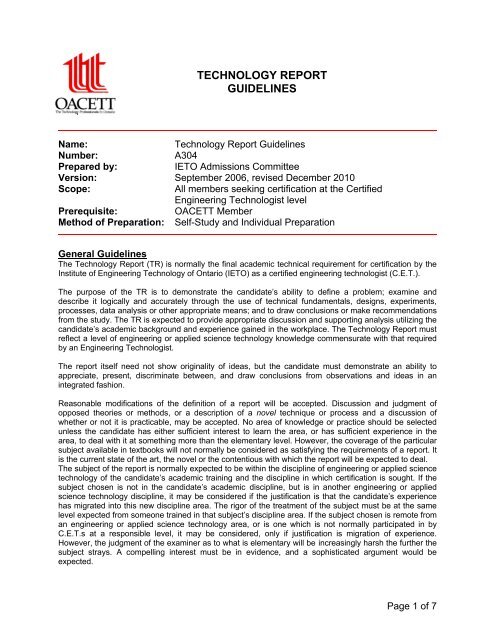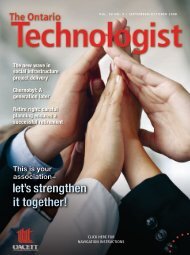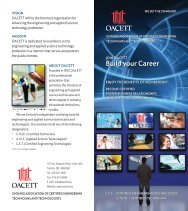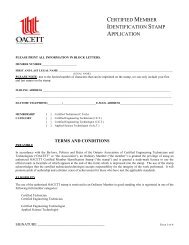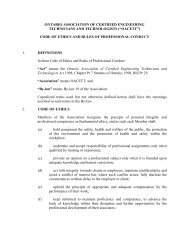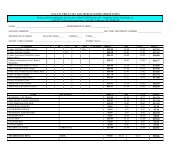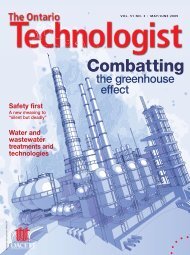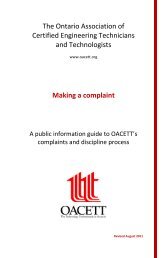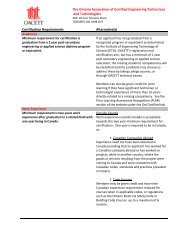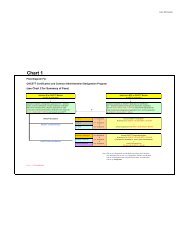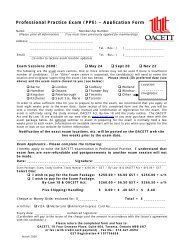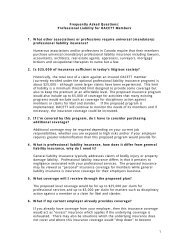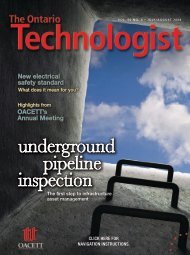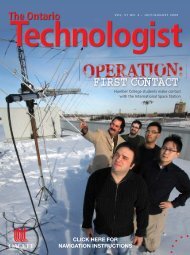TECHNOLOGY REPORT GUIDELINES - oacett
TECHNOLOGY REPORT GUIDELINES - oacett
TECHNOLOGY REPORT GUIDELINES - oacett
Create successful ePaper yourself
Turn your PDF publications into a flip-book with our unique Google optimized e-Paper software.
<strong>TECHNOLOGY</strong> <strong>REPORT</strong><br />
<strong>GUIDELINES</strong><br />
Name: Technology Report Guidelines<br />
Number: A304<br />
Prepared by: IETO Admissions Committee<br />
Version: September 2006, revised December 2010<br />
Scope: All members seeking certification at the Certified<br />
Engineering Technologist level<br />
Prerequisite: OACETT Member<br />
Method of Preparation: Self-Study and Individual Preparation<br />
General Guidelines<br />
The Technology Report (TR) is normally the final academic technical requirement for certification by the<br />
Institute of Engineering Technology of Ontario (IETO) as a certified engineering technologist (C.E.T.).<br />
The purpose of the TR is to demonstrate the candidate’s ability to define a problem; examine and<br />
describe it logically and accurately through the use of technical fundamentals, designs, experiments,<br />
processes, data analysis or other appropriate means; and to draw conclusions or make recommendations<br />
from the study. The TR is expected to provide appropriate discussion and supporting analysis utilizing the<br />
candidate’s academic background and experience gained in the workplace. The Technology Report must<br />
reflect a level of engineering or applied science technology knowledge commensurate with that required<br />
by an Engineering Technologist.<br />
The report itself need not show originality of ideas, but the candidate must demonstrate an ability to<br />
appreciate, present, discriminate between, and draw conclusions from observations and ideas in an<br />
integrated fashion.<br />
Reasonable modifications of the definition of a report will be accepted. Discussion and judgment of<br />
opposed theories or methods, or a description of a novel technique or process and a discussion of<br />
whether or not it is practicable, may be accepted. No area of knowledge or practice should be selected<br />
unless the candidate has either sufficient interest to learn the area, or has sufficient experience in the<br />
area, to deal with it at something more than the elementary level. However, the coverage of the particular<br />
subject available in textbooks will not normally be considered as satisfying the requirements of a report. It<br />
is the current state of the art, the novel or the contentious with which the report will be expected to deal.<br />
The subject of the report is normally expected to be within the discipline of engineering or applied science<br />
technology of the candidate’s academic training and the discipline in which certification is sought. If the<br />
subject chosen is not in the candidate’s academic discipline, but is in another engineering or applied<br />
science technology discipline, it may be considered if the justification is that the candidate’s experience<br />
has migrated into this new discipline area. The rigor of the treatment of the subject must be at the same<br />
level expected from someone trained in that subject’s discipline area. If the subject chosen is remote from<br />
an engineering or applied science technology area, or is one which is not normally participated in by<br />
C.E.T.s at a responsible level, it may be considered, only if justification is migration of experience.<br />
However, the judgment of the examiner as to what is elementary will be increasingly harsh the further the<br />
subject strays. A compelling interest must be in evidence, and a sophisticated argument would be<br />
expected.<br />
Page 1 of 7
Reports must be guaranteed to be the candidate’s own work. A TR prepared as a group activity will not<br />
normally be considered; however, a recent, undergraduate, final-year report, prepared as a requirement<br />
of an engineering or applied science technology program of studies, will be considered if all other<br />
requirements are met save actual work experience at the time the report was prepared.<br />
Two-Step Process<br />
Successful completion of the Technology Report involves two distinct steps; the first is a pre-requisite to<br />
the second.<br />
First, candidates must submit for approval a “Proposal for a Technology Report”. This proposal must be<br />
received and approved before proceeding to the second step.<br />
Second, upon receiving approval of the proposal candidates may complete and submit the actual<br />
Technology Report. Candidates will be given a grade of “Satisfactory”, “Unsatisfactory”, or returned with<br />
suggested modifications. Only those who receive “Satisfactory” will be considered to have met the<br />
necessary requirements for completion of the Technology Report.<br />
I The Technology Report Proposal<br />
The TR Proposal advises the IETO Admissions Committee of the author’s intent to submit a TR. It gives<br />
both the committee and the candidate an opportunity to determine whether the topic and proposed<br />
treatment would potentially result in an acceptable TR. The candidate must receive approval before<br />
proceeding to the TR.<br />
Normally a proposal will be a total of about 500 words divided into several sections. The TR Proposal<br />
should contain:<br />
Title page with the following information:<br />
Title: The proposed title for the TR. It should be specific, contain fewer than 10<br />
words, and use standard terminology.<br />
From: Candidate’s name, membership number and address<br />
Discipline: The Discipline in which certification is sought.<br />
Date: Date of submission<br />
Introduction: A short background statement, in about 100 words, of what the proposal covers and why<br />
this particular report is being prepared.<br />
Body: This section outlines the problem and methodology which the TR will attempt to address.<br />
(a) The problem should provide sufficient detail using specific engineering or applied<br />
science concepts/techniques/processes to identify what is wrong. Care should be taken<br />
to ensure that it is really a problem versus a summary or overview. (Proposals that are<br />
summaries of an industry or situation without seeking to solve an issue are unlikely to be<br />
approved.) The problem statement typically would not exceed 50 words.<br />
(b) The methodology describes concisely the approach the author intends to use in the<br />
TR’s investigation and documentation. The methodology description would normally be<br />
about 300 words.<br />
Page 2 of 7
Hypothesis: An effective hypothesis statement describes what the author thinks the solution to the<br />
problem is expected to be and why. It should be strong and clear and not contain any<br />
words such as “may be”, “probably”, or “might”. A hypothesis statement typically would<br />
not exceed 50 words.<br />
Proposal Submission<br />
The proposal should be sent via email as a Word or PDF attachment to Vera Alexeeva, Admissions<br />
Coordinator at valexeeva@<strong>oacett</strong>.org<br />
Approval Considerations<br />
When the Proposal for a Technology Report has been approved, the TR may be prepared. A Technology<br />
Report will not be accepted for consideration unless a Proposal has been submitted and approved.<br />
The TR must be submitted within one year of the approval of the Proposal for a Technology Report.<br />
Sample Topics and Titles<br />
A Technology Report should relate to the discipline in which certification is sought and describe a<br />
comprehensive study of an engineering or applied science topic. Sample topics might include a Design;<br />
Testing and Analysis; Selection or Development of a Process or Equipment; or a Technical Site<br />
Assessment.<br />
Titles from previous TRs have been:<br />
Chemical<br />
• A Study of the Effects of Filler Concentration and Shear Rate on the Viscosity of a Filled Polymer<br />
Compound<br />
• Heavy Water Properties in a Computer Blowdown Code for Nuclear Reactors<br />
• Analysis of Ethyl Carbonate in Wine<br />
Electronics<br />
• Three Position Elevator Model with Soft Start and Soft Stop<br />
• Continuous Online Catalyst Loading<br />
• Audio Spectrum Analyzer<br />
• Subcarrier Multiplexing on Fiber Optic Networks<br />
• Gas Monitoring Measurement Techniques<br />
Civil<br />
• Traffic Calming: An Evaluation of Tools and Policy for Ontario<br />
• Lake Oxygen Restoration Project<br />
• Fuel Oil Tank Decommissioning and Impacted Soil Removal<br />
• The Design and Analysis of a Retaining Wall on an Irregular Slope<br />
Environmental<br />
• An Environmental Health Assessment of Grenadier Pond<br />
• Laboratory Analysis Utilizing an Atomic Absorption Spectrometer<br />
• Quantifying the Stormwater Pollutant Reduction Benefits Associated with Traditional Public Works<br />
Maintenance Practices<br />
Mechanical<br />
• The Design and Development of a Coat Hook Assembly for an Automotive Interior Application<br />
• How to Manufacture More Effectively Using Laser Technology<br />
• Improving Indoor Air Quality in a Residential Application<br />
Page 3 of 7
II The Technology Report<br />
In addition to providing a reasoned investigation and analysis into an engineering or applied science<br />
technology problem, the TR must communicate the information in a standard, comprehensible manner<br />
following acceptable style, formatting and language considerations. Thus, the report will be evaluated in<br />
two major areas: Structure and Mechanics; and Technology Content. Each must be considered<br />
acceptable to achieve a final grade of “Satisfactory”.<br />
1. Structure and Mechanics<br />
Typically the following components will be present in the TR:<br />
• Title Page (include the following):<br />
◊ Your name, current OACETT designation (if any), and membership number<br />
◊ Title should be brief, ten words or less.<br />
◊ Date of submission<br />
• Declaration of Sole Authorship<br />
• Copy of the approved proposal, not the approval letter/email<br />
• Abstract (also known as a Summary or Executive Summary or Foreword)<br />
◊ An accurate condensation of the TR. State the main idea or thesis by answering<br />
questions such as:<br />
What is the TR about?<br />
Why is it significant?<br />
What should I do about it?<br />
• Table of Contents<br />
• List of Illustrations or Diagrams (if any)<br />
• Introduction (Including the problem statement)<br />
◊ What is the technical problem?<br />
◊ Why was the work described in the TR undertaken?<br />
◊ What is included and/or omitted? What is the scope of the report and what procedures<br />
are used?<br />
◊ What is your objective?<br />
◊ What unique problems were encountered in doing or interpreting the work?<br />
◊ Are there unique approaches in the study?<br />
• Body (Content) (discussion of the problem with diagrams, illustrations, tables, calculations,<br />
observations, etc.) with section headings<br />
• Conclusion(s)<br />
◊ A conclusion interprets the data found in the Body. It is reasoned judgment and not<br />
opinions. Consider the variables. Relate cause and effect. Analyze, evaluate, make<br />
comparisons and contrasts. Base the conclusion on fact.<br />
• Recommendation(s) (if any)<br />
◊ Recommendations are not required for all studies. They suggest a course of action and<br />
would generally be provided when there are additional areas for study, or if the reason for<br />
the TR was to determine the best action going forward.<br />
• Bibliography (Technical References)<br />
• Appendices (including detailed calculations, tables, drawings, specifications, technical literature,<br />
acknowledgements, etc.)<br />
Each TR should follow acceptable style and language usage including:<br />
• Typed, double-spaced using Arial, Univers, or a Sans Serif 12-point font<br />
• Justified left, with numbered pages and appropriate page breaks (no “widows” or “orphans”)<br />
• Correct spelling, punctuation, and grammar<br />
• Consistent voice, subject-verb agreement, tense<br />
• Little or no use of jargon<br />
• Acronyms explained<br />
• Correct use of references, footnotes, quotations, paraphrasing<br />
Page 4 of 7
2. Technology Content<br />
The body of the TR must contain at least 3000 words not including Bibliographies and Appendices.<br />
Assume readers know little about the area of study. Provide sufficient background to give a reasonable<br />
understanding of the presentation. Supply details of what was done in the study including what materials,<br />
equipment and procedures were used; and why they were selected over other alternatives. If the work is<br />
experimental provide drawings of the setup. If the work is a design development be sure to include the<br />
calculations. Additional calculations and references can be included in an Appendix rather than the Body.<br />
Ensure the following:<br />
• The methodology is scientifically sound and that the engineering technology principles are<br />
appropriate to the subject area.<br />
• The data and results are complete.<br />
• Mathematical formulae have been applied appropriately.<br />
• Illustrations/Diagrams/Charts are technically correct.<br />
• The analysis is complete.<br />
Summarize the results and illustrate the most significant ones. A result is something obtained by<br />
calculation or investigation. They should be accurate and follow sound scientific and engineering<br />
principles. Results lead to meaningful conclusions from the data whether it was determined from<br />
experiments, theories or secondary sources. The conclusion/recommendation should be logical and<br />
relate to and reflect the Problem Statement.<br />
Ownership of TR<br />
The TR will remain the property of OACETT and may be used to assist others in the preparation of their<br />
TRs. Arrangements may be made for members to view TRs in the OACETT office. See the preparation<br />
section below for further details.<br />
Confidentiality<br />
On occasion, a member may wish to submit a TR prepared on behalf of an employer which is proprietary<br />
to that employer. Special arrangements may be made with the Registrar for confidential or proprietary<br />
TRs, provided a written request is made in advance. OACETT will issue a standard, signed,<br />
confidentiality agreement for such requests. The TR will not become the property of OACETT and all<br />
copies will then be returned to the member on completion of the evaluation. Candidates must obtain their<br />
employer’s written permission prior to submitting the TR to OACETT.<br />
Authorship<br />
A signed declaration that the TR is the candidate’s own work must be provided. A TR prepared as a<br />
group activity will not normally be considered. A statement of sole authorship (included on the Title Page<br />
or as a separate page) should be worded as follows:<br />
I,________________________, confirm that this work submitted for assessment is my own and is<br />
expressed in my own words. Any uses made within it of the works of any other author, in any form (ideas,<br />
equations, figures, texts, tables, programs), are properly acknowledged at the point of use. A list of the<br />
references used is included.<br />
It is mandatory that all sources of information be acknowledged in the TR. Plagiarism is unethical and a<br />
candidate suspected of plagiarizing may be referred to the Complaints Committee.<br />
Page 5 of 7
Preparation<br />
Candidates are responsible for their own self study and individual preparation using these guidelines.<br />
From time to time OACETT may offer Technology Report Seminars. For information on TR Seminar dates<br />
and registration, please see the OACETT website www.<strong>oacett</strong>.org.<br />
To review satisfactory TRs, please contact OACETT during office hours (8:30 a.m. to 4:30 p.m.) Monday<br />
through Friday at 416.621.9621. Members are requested to call ahead and arrange appropriate times for<br />
reviewing Technology Reports. A declaration of confidentiality must be signed by all members prior to<br />
viewing these reports.<br />
Evaluation<br />
The Technology Report will receive a grade of either “Satisfactory” or "Unsatisfactory" or returned with<br />
suggested modifications. All unsatisfactory reports will be automatically re-reviewed prior to informing the<br />
member of the results of the evaluation. If “Unsatisfactory”, the Examiners will provide comments to<br />
assist with rewriting the TR. It may be resubmitted only once and only after appropriate revisions have<br />
been made. This must be done within three (3) months of the notification date of the results. If, after<br />
revisions the TR does not meet the OACETT standard, a new topic must be chosen and a new Proposal<br />
for a Technology Report submitted.<br />
Resources<br />
The following references may be useful in the preparation of a Technology Report:<br />
Blicq, Ron S. Technically Write! Pearson Education, 7 th edition, 2007<br />
Rubens, Philip. Science and Technical Writing: A Manual of Style, Routledge, 2 nd edition, 2000<br />
Submission of the Technology Report<br />
Submit one hard copy of the report, appropriately bound (spiral-bound, binder, duo-tang folder), plus a<br />
copy of the actual proposal you submitted earlier, addressed to:<br />
Institute of Engineering Technology of Ontario<br />
OACETT<br />
10 Four Seasons Place<br />
Suite 404<br />
Toronto ON M9B 6H7<br />
Page 6 of 7
Use the following checklist to ensure that the Technology Report meets OACETT basic<br />
requirements.<br />
Yes<br />
PS. 01 <br />
PS. 02 <br />
PS. 03 <br />
Report Check List<br />
Has a Proposal for a Technology Report been submitted and accepted and a copy of<br />
the approved proposal included in the TR?<br />
Has the TR been submitted within one year since the proposal was approved?<br />
Is the TR consistent with the Proposal (as approved and with the comments and<br />
suggestions made by the proposal reviewer/examiner)?<br />
PS. 04 Is the TR typed, double-spaced and justified left?<br />
PS. 05 Has a 12 point Arial, Univers, or similar Sans Serif font been used?<br />
PS. 06 Is the body of the report a minimum of 3,000 words?<br />
PS. 07 Are the components in the following order: Title Page; Declaration of Authorship;<br />
Executive Summary/ Abstract/ Introduction/ Foreword; Table of Contents; Lists of<br />
Illustrations/Diagrams; Body of the TR; Conclusions and Recommendations;<br />
Bibliography/Technical References; and Appendices ?<br />
PS. 08 Is there a signed Declaration of Sole Authorship?<br />
PS. 09 Is the report dated?<br />
PS. 10 Is the TR current? (The TR should be less than 5 years old.)<br />
PS. 11 Is there a Title Page?<br />
PS. 12 Is there a Table of Contents?<br />
PS. 13 Does the Table of Contents correctly reflect the Components: Headings,<br />
Illustrations/Diagrams and Appendices?<br />
PS. 14 Are the pages numbered with appropriate page breaks?<br />
PS. 15 Is there an Abstract/Executive Summary, Introduction/Foreword? (any one is<br />
acceptable)<br />
PS. 16 Does the body of the report contain Section Headings?<br />
PS. 17 Are Conclusions and/or Recommendations provided?<br />
PS. 18 Is there a Bibliography with Technical References?<br />
Page 7 of 7


